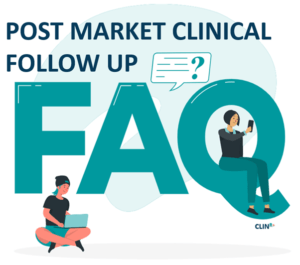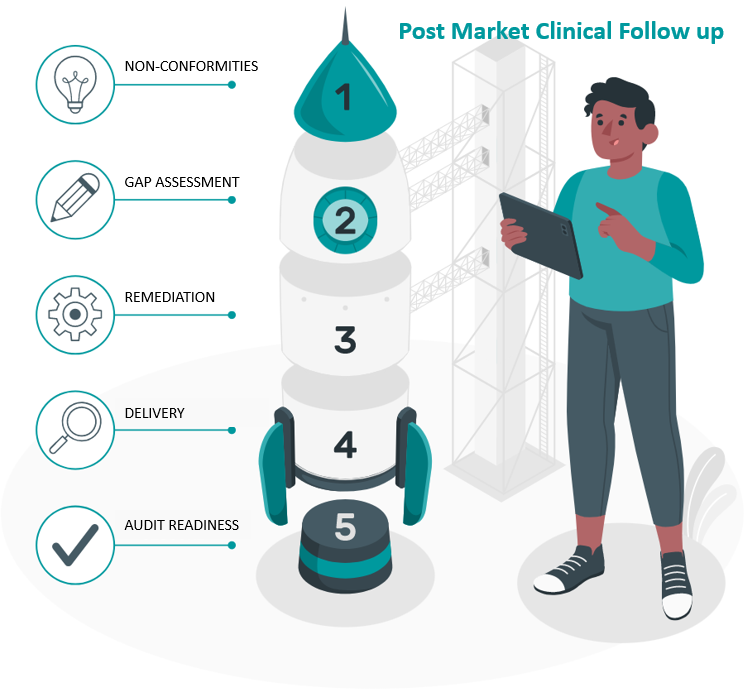Post Market Clinical Follow up FAQ

Q: What is Post Market Clinical Follow-up (PMCF)?
A: Post Market Clinical Follow-up (PMCF) is a continuous clinical data gathering process that involves collecting clinical data, documentation, and evidence for a CE-marked medical device. It aims to proactively identify safety or performance issues, update the device’s clinical evaluation, and ensure its overall safety and performance throughout its lifetime.
Q: What are the objectives of PMCF under the EU MDR?
A: The objectives of PMCF include identifying and investigating safety data (harms and adverse events), contributing to the update of the Clinical Evaluation, detecting new risks, monitoring residual risks and side effects, confirming the device’s benefit-risk profile, and identifying systematic device misuse and its impact on safety and performance.
Q: What should be included in a PMCF Plan to ensure EU MDR compliance?
A: A PMCF Plan should include general methods and procedures for post-market clinical follow-up, specific methods and procedures for PMCF (such as evaluation of registers or clinical studies), a rationale for the chosen methods, references to relevant parts of the Clinical Evaluation Report and risk management, specific objectives and clinical data gaps, an evaluation of clinical data from equivalent devices, references to relevant standards and guidance, and a detailed time schedule for PMCF activities. See MDCG 2020-8: PMCF Evaluation Report and MDCG 2021-6 for further information.
Q: What are the challenges in conducting PMCF studies under the EU MDR?
A: One of the challenges is defining “sufficient clinical evidence” and determining the appropriate quantity and quality of data needed. Collaboration with other departments, such as sales and marketing, is crucial for cross-functional alignment. Another challenge is ensuring that documentation provides adequate detail, including justifications for the chosen volume and type of clinical data. See MDCG 2020-6 for more details on how to determine of your device has sufficient evidence or enquire from a Clinical Regulatory expert to conduct a Gap Analysis on your ‘Technical Document’ to determine sufficiency.
Q: How can manufacturers ensure compliance with PMCF requirements?
A: Manufacturers should develop a PMCF strategy that aligns with the EU MDR and ISO 14155 standards. They should understand their PMCF options, costs, and effectiveness for each device type. Adequate resources and skills should be allocated, considering the most cost-effective solution. Justifications for PMCF plans should be based on good scientific principles, include measurable goals, and be extensively documented. Collaboration among relevant stakeholders is essential to ensure compliance.
Q: What role does Real World Data (RWD) and Real World Evidence (RWE) play in PMCF?
A: RWD refers to patient health data collected from various sources, such as electronic health records, product registries, and wearable devices. RWE is the analysis of RWD to generate clinical evidence regarding a medical product’s use, benefits, and risks. RWD and RWE can be used to support clinical trial designs, explore new treatment methods, and provide post-market surveillance data. These sources of data can contribute to PMCF activities and enhance the understanding of a device’s performance in real-world settings.
Q: What are some best practices for PMCF planning and implementation?
A: Best practices for PMCF include adopting a consistent approach for assessing and identifying data, ensuring cross-functional collaboration and alignment with other departments, developing a PMCF strategy that complies with the EU MDR and ISO 14155, providing detailed documentation with strong justifications, and considering the cost-effectiveness of different PMCF activities. Regular evaluation and adaptation of the PMCF plan based on data collected and regulatory changes are also recommended.
Related Articles
Fast Tracked PMCF Activities
This case study looks at fast tracked PMCF activities and how CLIN-r+ supported one manufacturer with their Clinical Data Acquisition for EU MDR submission from ...
Read More →
Post Market Clinical Follow up (PMCF)
The EU MDR increases the need for Post Market Surveillance (PMS), and therefore Post Market Clinical Follow up (PMCF). CLIN-r+ explains how manufacturers will need ...
Read More →
Clinical Investigations for Medical Devices and IVD
Clin-r+ outlines the requirements and considerations manufacturers should review to ensure that Clinical Investigations they undertake are well researched to ensure a return on investment.
Read More →






